In recent years, chatbots have become increasingly popular in various industries, including customer service, e-commerce, and healthcare. As the demand for chatbots continues to grow, developers are constantly exploring new and innovative ways to improve their functionality and performance. In this article, we will explore the future of From ELIZA to Chat GPT chatbots and some of the most exciting developments in the field.
What are chatbots?
Before we delve into the next generation of chatbots, let’s first define what a chatbot is. A chatbot is a computer program design to simulate conversation with human users, often through messaging applications, websites, or mobile apps. Chatbots can be programmed to handle a variety of tasks, from answering customer queries to assisting with medical diagnosis.
ELIZA chatbot: The early days
One of the earliest chatbots was ELIZA, developed in the 1960s by Joseph Weizenbaum. ELIZA was design to mimic a psychotherapist by using pattern recognition and natural language processing (NLP) techniques.
Google Lambda: Taking chatbots to the cloud
Fast forward to the present day, and we have Google Lambda, a cloud-based chatbot platform that utilizes machine learning and NLP to provide natural and intuitive conversations. Google Lambda is designed to be highly scalable, allowing businesses to create chatbots that can handle millions of conversations simultaneously.
Psychology chatbot: Woebot
One area where chatbots are making significant strides is in mental health.Woebot can provide personalized support 24/7, making it an ideal solution for individuals who may not have access to traditional therapy.
BARD chatbot: The future of AI
As artificial intelligence (AI) continues to evolve, chatbots are becoming more advanced and sophisticated. BARD, for example, is a chatbot develop by researchers at the University of Cambridge that is design to generate creative writing, poetry, and music. BARD utilizes deep learning algorithms and can produce high-quality content that rivals that of human writers.
Chat GPT: The future is here
At the forefront of chatbot development is Chat GPT, From ELIZA to Chat GPT a next-generation chatbot that utilizes advanced AI and NLP techniques to provide human-like conversations. Chat GPT is based on the GPT-3 architecture and can understand context, generate responses, and even provide creative input. Chat GPT is being use in a variety of industries, including healthcare, finance, and e-commerce.
Conclusion
The future of chatbots is bright, with developers constantly pushing the boundaries of what is possible. From ELIZA to Chat GPT, we have seen significant advancements in chatbot technology, with AI and machine learning playing a crucial role.As chatbots continue to evolve and become more prevalent, it is likely that they will have an increasingly prominent role in our daily routines.
FAQs
- What is the future of chatbots?
The future of chatbots is bright, with developers constantly pushing the boundaries of what is possible. We can expect to see more advanced and sophisticated chatbots that utilize AI and machine learning to provide more human-like conversations. - What is ELIZA chatbot?
ELIZA was one of the earliest chatbots developed in the 1960s by Joseph Weizenbaum. It was designed to mimic a psychotherapist by using pattern recognition and NLP techniques. - What is Woebot?
Woebot is a psychology chatbot that utilizes cognitive-behavioral therapy (CBT) techniques to help users manage their mental health. It provides personalized support 24/7, making it an ideal solution for individuals who may not have access to traditional therapy. - What is BARD chatbot?
It utilizes deep learning algorithms and can produce high-quality content that rivals that of human writers. - What is Chat GPT?
Chat GPT is a next-generation chatbot that utilizes advanced AI and NLP techniques to provide human-like conversations. It is based on the GPT-3 architecture and can understand context, generate responses, and even provide creative input. Chat GPT is being use in a variety of industries, including healthcare, finance, and e-commerce. - How can chatbots benefit businesses?
Chatbots can benefit businesses in many ways, including providing instant support to customers, handling repetitive tasks, and improving efficiency. With advancements in AI and machine learning, chatbots have become more intelligent, sophisticated, and capable of handling a wide range of tasks. From customer service to mental health support, chatbots are being use in various industries to improve efficiency, productivity, and customer satisfaction. As chatbot technology continues to evolve, we can expect to see even more exciting developments in the future.



